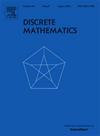Toughness, Hamiltonicity and eigenvalues of graphs
IF 0.7
3区 数学
Q2 MATHEMATICS
引用次数: 0
Abstract
For a real number , we say a graph is t-tough if for all with , where is the number of components of . The toughness of G is the maximum t for which G is t-tough. Firstly, we provide a lower bound for in terms of its normalized Laplacian eigenvalues, improving or generalizing known lower bounds established by Huang, Das and Zhu (2022), Gu (2021) and Zhang (2023). We also derive upper bounds for certain eigenvalues in a regular graph to ensure that the graph is t-tough, where is an integer, which extends the related result of Cioabă and Wong (2014). Additionally, we establish a sufficient condition involving the number of r-cliques to ensure the existence of a Hamiltonian cycle in a t-tough graph, where r is an integer with , which improves upon the sufficient condition based on the number of edges proposed by Cai, Yu, Xu and Yu (2022). Finally, we provide a spectral condition to guarantee the existence of a Hamiltonian cycle in t-tough graphs, thereby addressing the problem posed by Fan, Lin and Lu (2023) for integers .
图的韧性、哈密性和特征值
对于实数t≥0,当c(G−S)≥2时,对于所有的S蔓生V(G),如果|S|≥t⋅c(G−S),我们称图G=(V,E)为t-tough,其中c(G−S)为G−S的分量个数。G的韧性τ(G)是使G为t韧性的最大t。首先,我们根据τ(G)的归一化拉普拉斯特征值提供了一个下界,改进或推广了Huang、Das和Zhu(2022)、Gu(2021)和Zhang(2023)建立的已知下界。我们还推导了正则图中某些特征值的上界,以确保图是t-tough的,其中1t为整数,扩展了cioabei and Wong(2014)的相关结果。另外,在Cai, Yu, Xu和Yu(2022)提出的边数充分条件的基础上,我们建立了t-tough图中r为r≥2的整数的r-团数的充分条件,保证了t-tough图中哈密顿循环存在。最后,我们给出了t-tough图中哈密顿循环存在的谱条件,从而解决了Fan, Lin和Lu(2023)对整数t≥1提出的问题。
本文章由计算机程序翻译,如有差异,请以英文原文为准。
求助全文
约1分钟内获得全文
求助全文
来源期刊

Discrete Mathematics
数学-数学
CiteScore
1.50
自引率
12.50%
发文量
424
审稿时长
6 months
期刊介绍:
Discrete Mathematics provides a common forum for significant research in many areas of discrete mathematics and combinatorics. Among the fields covered by Discrete Mathematics are graph and hypergraph theory, enumeration, coding theory, block designs, the combinatorics of partially ordered sets, extremal set theory, matroid theory, algebraic combinatorics, discrete geometry, matrices, and discrete probability theory.
Items in the journal include research articles (Contributions or Notes, depending on length) and survey/expository articles (Perspectives). Efforts are made to process the submission of Notes (short articles) quickly. The Perspectives section features expository articles accessible to a broad audience that cast new light or present unifying points of view on well-known or insufficiently-known topics.
 求助内容:
求助内容: 应助结果提醒方式:
应助结果提醒方式:


